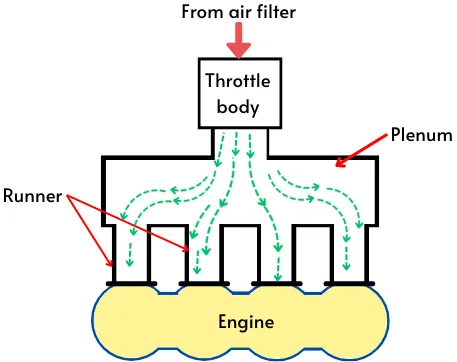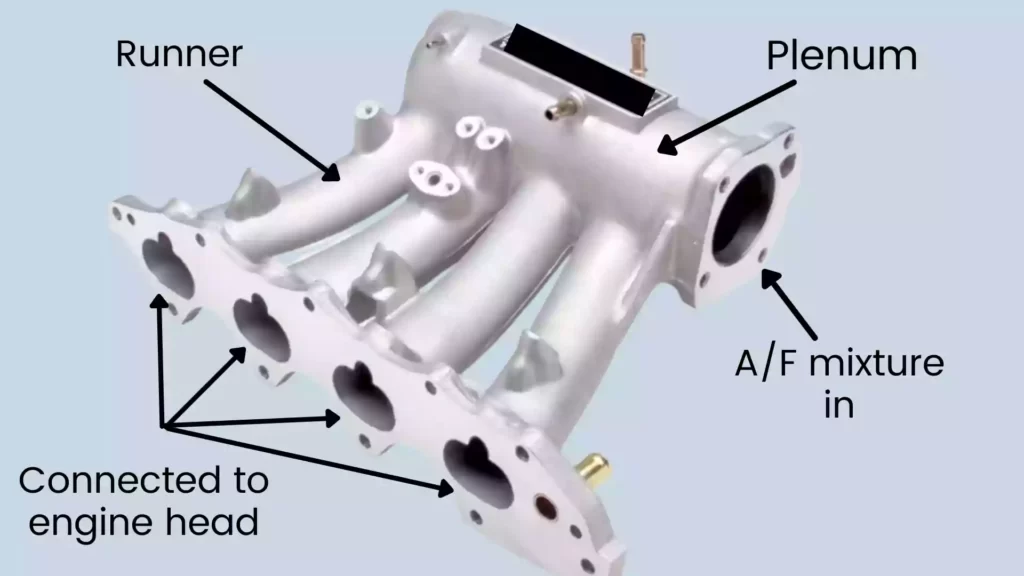The intake manifold is one of the part of IC engine which connects the carburetor/ throttling body to the cylinder head. Today we are going to deep dive about the Intake manifold, its functions, types and many things. So, lets start.
In this article, we’re going to discuss:
- What is the Intake manifold in a engine?
- Construction:
- Types of intake manifold:
- Function of Intake manifold:
- Final words:
What is the Intake manifold in a engine?
The intake manifold (also known as the inlet manifold) is the component used to deliver an equal proportion of intake charge to each cylinder of the engine.
It delivers an equal amount of charge to all cylinders to get higher performance from the engine.
In carbureted engines, it is connected between the carburetor and cylinder head while in fuel-injected engines, it helps to connect the throttle body to the cylinder head.

In SI engines without carburetors, the formation of an air-fuel mixture is completed in the intake manifold.
For this purpose, a fuel injector is mounted before the throttle body or provided into the runner of an intake manifold closer to the intake valve.
The intake manifold generally consists of a runner for each cylinder and a common chamber called a plenum connected to all runners.
Construction:
The inlet manifold is the major part of an Internal combustion engine that consists of cast iron or aluminum.
As aluminum has the advantage of being lightweight, it is generally preferred to cast the intake manifold. Currently, it is also made up of composite materials.

The intake manifold consists of the following two types of components.
1) Plenum: The plenum connects all the runners together and it is comparatively larger in size. One end of the plenum is connected to the carburetor or throttle body.
The role of the plenum is to feed all the runners equally with the fresh charge coming from the throttle body.
2) Runner: Runners connect the plenum to the individual cylinder head and it carries the air-fuel mixture or air from the plenum to the cylinder. The number of runners depends on the number of cylinders in the engine.
In the MPFI system, the fuel injectors are mounted on the runners, and spray the gasoline into the runner near the opening of the intake valve.
Types of intake manifold:
Depending on the number of plenums, the inlet manifold is divided as follows:
1) Dual plane intake manifold: The plenum area in this type of intake manifold is split into two sections at the opening connected to the carburetor.
Further, each plenum is connected to about 4 cylinder heads by using runners. In this type, the intake charge is divided by both plenum sections.
2) Single plane Intake manifold: It has a single plenum section that is connected further to the cylinder heads by means of runners.
Function of Intake manifold:
The following are some of the main functions of the intake manifold:
1) Distribute intake charge evenly to all cylinders: The intake manifold is used to connect the carburetor or throttle body to the cylinder head and helps to supply the air or air-fuel mixture to all the cylinders in equal proportion.
2) Gasoline injection: In some intake manifolds, the fuel is spread inside the intake manifold by using the fuel injectors. The intake manifold has provision for mounting fuel injectors.
3) The good intake manifold also avoids pressure loss.
4) Provision for mounting different sensors: The intake manifold also has the provision to mount different sensors for testing the density, oxygen amount of air, and other parameters.
5) The runner position valve/sensor is mounted on the intake manifold which controls the opening of the flap inside of the intake manifold to control the flow of air.
6] Source of vacuum for different functions: The vacuum created inside the intake manifold is used to run different systems line brake boosters, vacuum clutch, etc.
Final words:
The intake manifold is the significant component of an engine that is used to supply the air-fuel mixture to all the cylinders. The intake manifolds are designed in such a way that it offers less pressure loss in the plenum and runners. A good intake manifold helps to increase the performance of the engine.
So much proud of this ,bcz it help me to learn more